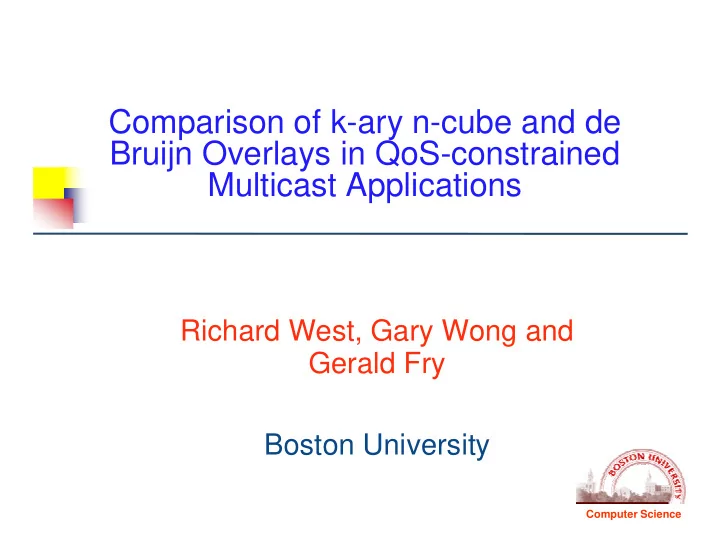

Comparison of k-ary n-cube and de Bruijn Overlays in QoS-constrained Multicast Applications Richard West, Gary Wong and Gerald Fry Boston University Computer Science
Introduction Computer Science � Our goal is a multicast system which can: � Guarantee timely delivery of data � Scale to many thousands of end hosts � We consider an overlay infrastructure built using a regular graph topology, to: � Reduce the end-to-end hop count � Allow simple and flexible routing � Minimise link stress on the underlying physical network � Two regular graphs: k-ary n-cubes and de Bruijn graphs
k-ary n-cubes Computer Science � M=k n nodes � Node ID: n base-k digits [011] [111] � Neighbors have n-1 10 B C common digits in their 8 18 7 14 IDs 16 [010] A D � ith digit in each ID differs 21 [101] F G by +/- 1 mod k 10 12 19 18 � Graph diameter: n � k/2 � E H 16 [000] [100] Node F ID = 001, Node D ID = 110 Nodes B and E are failed nodes
de Bruijn Graphs Computer Science � M=k n nodes � Node ID: n base-k digits [001] [011] B F � Neighbors: directed [111] [101] edge from A to B iff last D A E H n-1 digits of A match 1 st [000] [010] C n-1 digits of B G [100] [110] � Graph diameter: n
Route Availability Computer Science � How many routes exist between a given source/destination pair? � k -ary n -cubes: ( � k/2 � n )! / ( � k/2 � ! ) n � de Bruijn graphs: � Only a single path with minimal hop count exists � If we allow the source to route via an alternative peer (for redundancy), then in general there exist k-1 non- overlapping “backup” paths, of length n+1
Fault Resilience Computer Science � What if a node along path from source (S) to destination (D) fails? � Suppose node H hops from D fails: � k-ary n-cubes: (H-1)(H-1)! alternative shortest paths � de Bruijn graphs: no backup paths as short as original
Table of Various Properties Computer Science Hop Count Local Routes Global Routes Nodes Degree Med Max Min Med Max Med Max k n k-ary n-cubes 2x10 18 2 20 1M 20 10 20 1 10 20 3.6M 3 13 1.6M 26 9 13 1 9 13 363K 6.2G k de Bruijn graphs 2 1M 2 19 20 1 1 (2) 1 (2) 3 1.6M 3 13 13 1 1 (3) 1 (3) 4 1M 4 10 10 1 1 (4) 1 (4) 5 2M 5 9 9 1 1 (5) 1 (5) 20 3.2M 20 5 5 1 1 (20) 1 (20) 26 12M 26 5 5 1 1 (26) 1 (26)
Multicast Tree Construction Computer Science � Consider different methods for multicast tree construction using regular overlay topologies, that affect: � Relative delay penalty: ratio of end-to-end delay across overlay to equivalent unicast latency at (physical) network level � Link stress: ratio of total msg transmissions to number of physical links involved � Normalized lateness: � 0 if end-to-end overlay delay (d) within subscriber deadlines (D) � (d – D) / D otherwise � Success ratio: Fraction of all subscribers satisfying their deadlines (D)
Experimental Evaluation Computer Science � GT-ITM used to simulate physical network w/ 5050 routers � Compare performance of each overlay using various routing strategies: � k-ary n-cubes: � ODR – route in a specific order of dimensions � Random – route in random dimensions as long as distance to destination is reduced at each hop � Greedy – choose next hop with lowest latency � de Bruijn – shift-based routing � e.g. 000 → 010 : 000 → 001 → 010
Relative Delay Penalty Computer Science � #�$ ����%� ������������������������������������ %��&���'� ! ��(��%��&���'�� ��(��)*�����*����� � " � � � � � � �� � � � �� �� ��� ��� � ����������������������������������� • k=2 n=16, SPT = Dijkstra’s shortest path routing across overlay
Link Stress Computer Science "�! %��&���'� ����%� ��� #�$ .�������/��)������� ���%�� �� �" ! � � ��� "�! ���" ���� �!��� �! �! �""��" ������ +���,���-� • 3-ary 13-cube versus de Bruijn graph with k=10 and n=6
Lateness Computer Science �1� %��&���'�����%������%� �1 )*�����*����������%�� .�������0������-�%�/������� �1� �1 �1� �1 �1� �1 1� 1 ��� "�! ���" ���� �!��� �! �! �""��" ������ +���,���-�
Success Ratio Computer Science subscriber deadline = random[min physical link delay, max link delay * diameter of k-ary n-cube] NOTE: success ratio is a relative metric -- Can be improved by increasing subscriber deadlines 1�� %��&���'�����%������%� 1�� )*�����*����������%�� 1�� 1�� ��������$���� 1� 1�! 1�� 1�" 1�� 1�� 1�� ��� "�! ���" ���� �!��� �! �! +���,���-�
Dynamic Characteristics Computer Science • e.g., supporting hosts joining system for k-ary n-cubes • ID space is set to M=k n with physical hosts randomly assigned logical IDs in this space • Each host responsible for 1 or more logical IDs depending on ID originally chosen randomly [000,001] [000,001] [010,011] [110,111] [010,011] [110,111] [101] [100] [100,101]
Conclusions and Future Work Computer Science � Compare k-ary n-cubes and de Bruijn graphs for routing data between source and many destinations w/ per-subscriber service constraints � May be less effective than building end-system multicast trees from the “ground up” (w/o considering overlay topology) BUT much simpler � Regular topologies could be candidates for large-scale streaming applications � Future work: An Internet-wide system for processing & delivery of data w/ per subscriber QoS
Recommend
More recommend